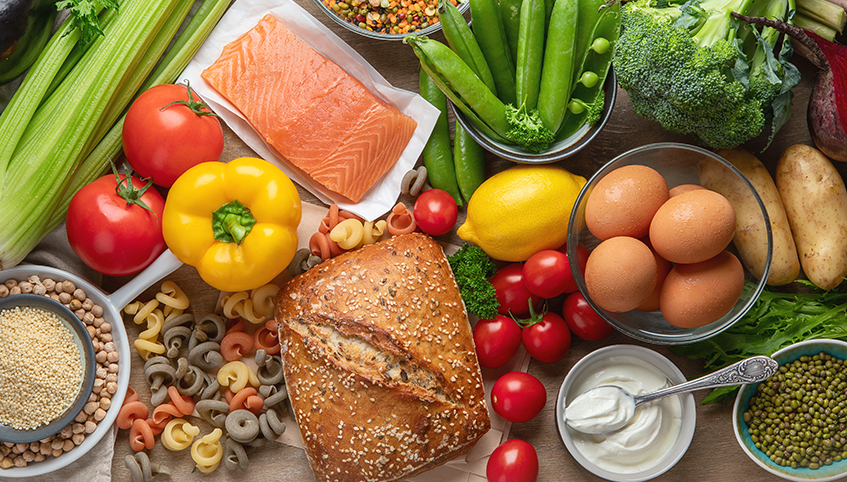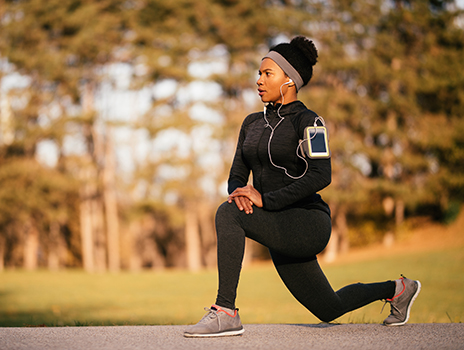December 19, 2023
Whether you’re a dedicated athlete or a casual jogger, you strive to perform your best. How you fuel your body can impact your performance in sports and athletic activities. Let’s dive into 7 ways you can boost your athletic performance by improving how you fuel your body.
1. Make sure you eat enough
Eating enough is crucial for athletes. Food provides the energy your body needs to perform well in sports and physical activities, in addition to keeping your body functioning properly. But it’s not enough to just fuel for your sport. You also need to make sure you have enough fuel left after exercise to use for building strong bones and skin, fighting off illness and recovering from activity.
Eating enough food to match your activity level can be challenging. This can cause what is called low energy availability (LEA). LEA is a sign that your body does not have enough energy left over after exercise to protect and grow your body.
LEA may even cause a female athlete to lose their monthly menstrual cycle. This is called amenorrhea. Female athletes without a menstrual cycle have about 6 times as many stress fractures in their career than those who do have a menstrual cycle. Athletes typically need at least 3 meals and 2-3 snacks daily to prevent LEA. You can meet with a sports dietitian to understand your body’s individualized needs.
2. Choose whole foods often
Choosing whole foods is like picking the best tools for your athletic journey. They provide your body with the energy and nutrients it needs to perform at its peak. Eating whole foods gives your muscles fuel to help you run faster, jump higher and get stronger. Here are some examples of whole-food choices.
- Choose Greek yogurt for your fruit smoothie instead of protein powder. Greek yogurt has about 20 grams of protein in a single cup.
- Add a fresh apple and sauteed spinach to your breakfast instead of a “greens” or “reds” powder. These supplements aren’t closely regulated, so they might not have precisely what they claim.
- Opt for a granola bar and cheese stick instead of a protein bar. Protein bars sometimes contain ingredients that can upset your stomach, like artificial fibers. While they can be handy in emergencies, they shouldn’t be a part of your daily eating pattern.
- Grill some chicken breasts instead of using collagen powder. Chicken has essential vitamins and minerals, like iron and vitamin B12, that collagen powder doesn’t provide.
3. Don’t skimp on carbohydrates
Carbohydrates are important for physical activity and can seriously boost your performance. They give you more energy for the effort you put in during your activity, compared to fats and proteins. They are also important for keeping your hormone levels, like estrogen and progesterone, in check. These hormones help regulate a female’s menstrual cycle each month and can also influence your bone mass. Carbohydrate foods should make up the biggest part of what you eat as an athlete. It’s been estimated that 45-95% of female athletes aren’t getting the carbohydrates they need for health and performance.
When you don’t eat enough carbohydrates, this can lead to what is called low carbohydrate availability (LCA). LCA may lead to more bone injuries and low bone mineral density, even if you’re eating enough food. Even a short period of carbohydrate restriction can affect your bone health. This happens by lowering the number of bone-building substances while increasing the amount of elements that break down your bones. Overall, this can lead to weaker bones. Aim to fill your plate half full of carbohydrate foods such as pasta, bread, rice, potatoes, quinoa, couscous and others.

4. Aim for The Athlete’s Plate®
There’s no one-size-fits-all way to eat for sports, but you can plan your meals to match how much energy you use during activity. The Athlete’s Plate® can serve as a visual guide to ensure you are fueling appropriately depending on how hard you're training. There are 3 versions of The Athlete’s Plate®: 1 for light training, 1 for moderate training and 1 for hard training.
- Light-training plate: 1/4 of your plate should be filled with carbohydrates, another 1/4 with protein and 1/2 with fruits and vegetables.
- Moderate-training plate: 1/3 carbohydrates, 1/3 protein and 1/3 fruits and vegetables.
- Hard-training plate: 1/2 carbohydrates, 1/4 protein and 1/4 vegetables with a side of fruit
This guide is designed to be used for meals only. You will most likely also need to eat snacks between meals to keep your energy levels up.
5. Don’t forget about snacks
Snacks play a crucial role in fueling an athlete. Due to the high training demand of sports and recreational activities, it can be difficult to get enough fuel by consuming only 3 meals daily. If you play a sport or engage in physical activity often, 2-3 snacks per day between meals can help you stay energized and on top of your performance. Here are some snack ideas:
- A peanut butter and honey sandwich on whole-wheat bread is a delicious way to get in carbohydrates, fiber, fats and protein between meals.
- A homemade Lunchable with crackers, cheese and deli meat is an easy, energy-sustaining snack.
- A tall glass of electrolyte-packed chocolate milk can replenish your body following an intense activity session.
- Pair a pack of fruit snacks with some nuts for a quick and convenient option.
6. Monitor your hydration
Staying well-hydrated is essential for athletes. Athletes need different amounts of hydration depending on their body size, what sport they do, how much they sweat and where they train. Here are some easy ways to make sure you’re drinking enough fluid.
- Check your urine: Look at how much and what color your urine is. It should be a light yellow, like lemonade, not clear.
- Monitor your weight loss around practice: If appropriate, you can weigh yourself before and after you play. Weight loss during activity will generally only be from sweating. If you lose more than 2% of your body weight, you might not be drinking enough fluid.
Read more about exactly how much water you should be drinking as an athlete.
7. Train your gut
You may need to consume carbohydrates and fluids to keep your energy level up during activity sessions. If your training session is longer than 1 hour, in hot and humid weather, high intensity or if you can't make it through your workout, you will benefit from consuming these nutrients during your workout. However, this may lead to digestive issues if your stomach isn't used to it.
It’s been estimated that 30-50% of athletes experience issues like bloating, cramps, diarrhea or vomiting while participating in their sport. When you train your gut, you are allowing your stomach to practice using this fuel during training, which can reduce digestive issues and improve nutrient delivery to your muscles.
Like any other athletic activity, training your gut takes practice and builds over time. Here are some steps to take:
- Determine if you should be fueling during your training. You can use the guidance provided above or meet with a sports dietitian.
- Select the products you will be using on race day or during an event, such as sports drinks, gels or others. Choose carbohydrate-containing sports drinks and gels for sessions under 2-3 hours. Solid foods work better for longer activity sessions.
- Begin practicing using the products early in your training, during 1-2 activity sessions per week. This is not something to begin right before a competition or race.
- Start with a fueling level that doesn’t upset your stomach – it’s individual to your tolerance.
- Gradually increase carbohydrates per hour each week until you hit your target. Most athletes may benefit from consuming 30-60 grams of carbs per hour of training.
- Keep a journal of what you consume and how you feel. Note how it affects your energy, digestion, performance and recovery from training.
- Get advice from a sports dietitian familiar with intra-workout fueling.
To get started with individualized recommendations, request an appointment with our sports dietitian by calling 913-239-0646 or emailing SportsNutrition@KUMC.edu.
